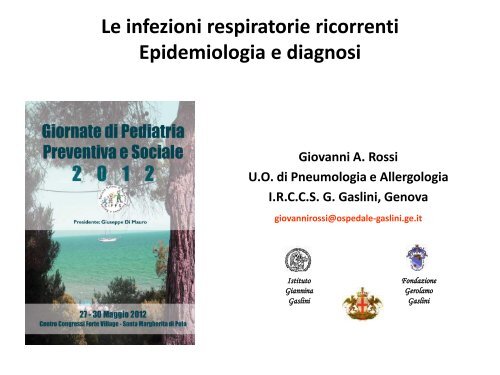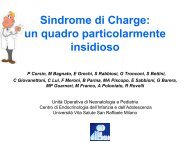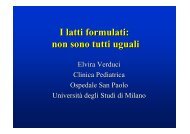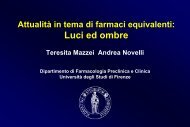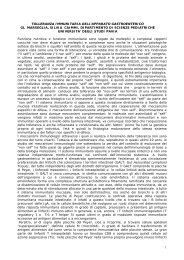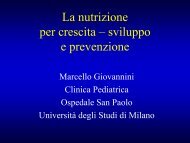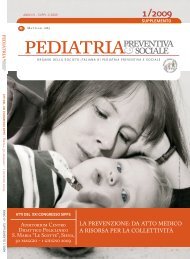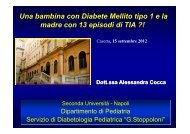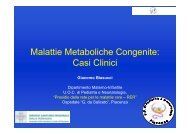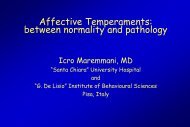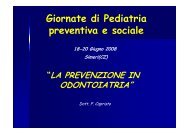Le infezioni respiratorie ricorrenti Epidemiologia e diagnosi ... - Sipps
Le infezioni respiratorie ricorrenti Epidemiologia e diagnosi ... - Sipps
Le infezioni respiratorie ricorrenti Epidemiologia e diagnosi ... - Sipps
You also want an ePaper? Increase the reach of your titles
YUMPU automatically turns print PDFs into web optimized ePapers that Google loves.
<strong>Le</strong> <strong>infezioni</strong> <strong>respiratorie</strong> <strong>ricorrenti</strong><br />
<strong>Epidemiologia</strong> e <strong>diagnosi</strong><br />
Giovanni A. Rossi<br />
U.O. di Pneumologia e Allergologia<br />
I.R.C.C.S. G. Gaslini, Genova<br />
giovannirossi@ospedale-gaslini.ge.it<br />
Istituto<br />
Giannina<br />
Gaslini<br />
Fondazione<br />
Gerolamo<br />
Gaslini
Outline<br />
• Cosa intendiamo per Infezioni Respiratorie Ricorrenti?<br />
• Perché i bambini in età prescolare sono più esposti alle Infezioni<br />
Respiratorie Ricorrenti ?<br />
• Cosa dobbiamo fare di fronte ad un bambino con Infezioni<br />
Respiratorie Ricorrenti ?<br />
La Diagnosi<br />
La Profilassi
<strong>Le</strong> Infezioni Respiratorie Ricorrenti?<br />
• Con “<strong>infezioni</strong> <strong>respiratorie</strong> <strong>ricorrenti</strong> (IRR)” ci<br />
si riferisce a una serie di episodi acuti a carico<br />
di uno o più settori definiti: il naso, l’orecchio,<br />
il faringe, le tonsille, il laringe, la trachea e i<br />
bronchi<br />
• Questa situazione si manifesta, solitamente, in età prescolare, in<br />
coincidenza della prima socializzazione del bambino con l’ingresso<br />
alla scuola materna<br />
• Benché si tratti di una patologia benigna destinata ad evolvere<br />
favorevolmente verso i 5-9 anni, essa interferisce notevolmente sul<br />
benessere del bambino e della famiglia e determina importanti<br />
costi medico sociali
% rispetto ai livelli negli adulti<br />
100<br />
80<br />
60<br />
40<br />
20<br />
0<br />
-<br />
-<br />
-<br />
-<br />
-<br />
Livelli di Ig seriche nel lattante<br />
Nascita<br />
IgG materne<br />
- -3 0 3 6 9 12 18<br />
Mesi<br />
IgM Bambino<br />
IgG Bambino<br />
IgA Bambino
La dimensione del problema<br />
Il bambino con IRR<br />
• In Italia il 6% dei bambini in età prescolare, presenta IRR nei<br />
primi 2-3 anni di vita<br />
Lancet 2003; 361: 51–59
Gli agenti eziologici<br />
• Gli agenti eziologici responsabili delle IRR siano<br />
identificabili solo occasionalmente, tuttavia<br />
quelli più frequentemente implicati sono i<br />
virus respiratori<br />
• La primitiva infezione virale può essere<br />
complicata da <strong>infezioni</strong> secondarie, causate sia<br />
da batteri che da virus con la comparsa di otiti<br />
medie, sinusiti ed <strong>infezioni</strong> broncopolmonari
Viral involved in the pathogenesis of upper<br />
respiratory tract infections<br />
Rhinoviruses 30 - 40%<br />
Coronaviruses 10 – 15%<br />
Influenza viruses 5 -15%<br />
Respiratory syncytial virus 5%<br />
Parainfluenza viruses 5%<br />
Adenoviruses < 5%<br />
Enteroviruses < 5%<br />
Metapneumovirus ? Unknown ?<br />
Unknown 20 – 30%<br />
Heikkinen T. Lancet 2003; 361: 51–59<br />
?<br />
0 20 40 60 80 100<br />
Estimated annual proportion of cases
Rhinovirus<br />
a … “soft” virus”<br />
• Epithelial cell cytotoxicity does not appear to play a major role in the<br />
pathogenesis of Rhinovirus (RV) infection that is characterized by RV-induced<br />
secretion of mediators of inflammation by airway structural/inflammatory cells
Seasonality and etiology of wheezing episodes in<br />
285 children in the 1st year of life<br />
Gern JE. JACI 2006;117:72-8.<br />
RV<br />
RV<br />
RV<br />
RV
Rhinoviruses replicate effectively at<br />
lower airway temperatures<br />
Rhinovirus serotypes 1b, 2, 7, 9, 14, 16, 41, and 70 titrated in Ohio-HeLa<br />
cell cultures at either 33°C or 37°C.<br />
Papadopoulos NG. Journal of Medical Virology 58:100–104 (1999)
Viral infections in relation to age among children<br />
hospitalized for wheezing<br />
Rhino<br />
RSV<br />
Heymann PW. JACI 2004: 114: 239-47.<br />
Rhino<br />
RSV<br />
Rhino<br />
RSV<br />
Rhino<br />
Influenza<br />
Rhinovirus<br />
RSV<br />
Other viruses<br />
Rhino
RV disrupts epithelial tight junctions and promotes<br />
transmigration of NTHi by paracellular route<br />
NTHi<br />
Control<br />
Sajjan U. AJRCCM 2008; 178: 1271–1281<br />
T.J.<br />
Zona occludins (ZO)-1<br />
NTHi<br />
Rhinovirus (RV) 39
Outline<br />
• Cosa intendiamo per Infezioni Respiratorie Ricorrenti?<br />
• Perché i bambini in età prescolare sono più esposti alle Infezioni<br />
Respiratorie Ricorrenti ?<br />
• Cosa dobbiamo fare di fronte ad un bambino con Infezioni<br />
Respiratorie Ricorrenti ?<br />
La Diagnosi<br />
La Profilassi<br />
La Terapia
Major risk factors for RRI in childhood<br />
Host-related<br />
• Low birth weight<br />
• Chronological age<br />
• Genetic factors<br />
• Atopy<br />
• Immunodeficiencies<br />
Immunity<br />
Environment-related<br />
• Day-care attendance<br />
• Having a siblings
Rhinovirus<br />
Allergic children have more numerous<br />
and severe respiratory infections than<br />
non-allergic children<br />
Number of RI/3 months<br />
A. Total RI Number<br />
2.50 -<br />
2.0 -<br />
1.5 -<br />
1.0 -<br />
0.5 -<br />
0.0<br />
1.26<br />
***<br />
0.94<br />
- Atopics Control<br />
Ciprandi G. Pediatr Allergy Immunol 2006: 17: 389–391<br />
Days<br />
B. Total RI Duration<br />
10 -<br />
8 -<br />
6 -<br />
4 -<br />
2 -<br />
8.92<br />
***<br />
4.85<br />
0 -<br />
Atopics Control
I.G.G.<br />
Vicious circle involving viral infection and allergic<br />
sensitization<br />
Viral<br />
infection<br />
Allergic<br />
sensitization
Interaction between atopy and viral<br />
infection at respiratory level<br />
HDM<br />
Increased<br />
epithelial<br />
permeability<br />
Airway<br />
Epithelial<br />
Cell<br />
Rhinovirus<br />
Oddera S. J of Asthma 1998; 35: 401-408.
Atopy and immunological disorders in<br />
218 preschool Italian children with RRI<br />
A. RRI & Atopy<br />
Dellepiane RM. Pediatr Med Chir 2009; 31: 161-4.<br />
-<br />
80 -<br />
60 -<br />
40 -<br />
20 -<br />
Atopic children (%) 100<br />
0 -<br />
50.5<br />
35.3<br />
IRR Control<br />
B. RRI & Immunological<br />
disorders*<br />
-<br />
40 -<br />
30 -<br />
20 -<br />
10 -<br />
Children with ID (n°) 50<br />
39<br />
0 -<br />
IRR<br />
*IgA and IgG2 deficiency<br />
and transient<br />
hypogammaglobulinemia<br />
Rhinovirus
Coexistence of (partial) immune defects in children<br />
(4-14 yrs old) with recurrent respiratory infections<br />
Belgium A. IgA and/or IgG<br />
B. Deficient Ab response to<br />
subclass deficiency<br />
Pneumococcal Polysaccharides<br />
40 -<br />
30 -<br />
20 -<br />
10 -<br />
% of children 50<br />
-<br />
0 -<br />
49%<br />
14%<br />
IRR Control<br />
There was no increase in the prevalence of partial C4 or C2 deficiency, lymphocyte subset<br />
deficiency, or FcRII polymorphism in the IRR patients compared to controls<br />
Bossuyt X. Clinical Chemistry 2007; 53: 124–130<br />
40 -<br />
30 -<br />
20 -<br />
10 -<br />
% of children 50<br />
-<br />
0 -<br />
19%<br />
0<br />
IRR Control
Turkey<br />
IgA and/or IgG subclass deficiency in 225 children<br />
aged 6 months to 6 years with RRI<br />
20 -<br />
15 -<br />
10 -<br />
5 -<br />
% of children 25<br />
IgG subclasses deficiency<br />
-<br />
9%<br />
19%<br />
8%<br />
2%<br />
0 -<br />
IgG3 IgG2 IgG2+IgG3<br />
Ozkan H. J Invest Allergol Clin Immunol 2005; 15: 69-74.
Outline<br />
• Cosa intendiamo per Infezioni Respiratorie Ricorrenti?<br />
• Perché i bambini in età prescolare sono più esposti alle Infezioni<br />
Respiratorie Ricorrenti ?<br />
• Cosa dobbiamo fare di fronte ad un bambino con Infezioni<br />
Respiratorie Ricorrenti ?<br />
La Diagnosi<br />
La Profilassi<br />
La Terapia
Diagnosis<br />
• Careful Medical History and Clinical Examination<br />
are usually sufficient to make a <strong>diagnosi</strong>s of RRI<br />
and no further examinations are generally<br />
needed in the majority of the cases<br />
• A complete Blood Count with differential is sufficient to<br />
exclude neutropenia, while the evaluation of Antibodies<br />
against Recall Antigens rules out T-lymphocyte defects<br />
• Total Immunoglobulin <strong>Le</strong>vels are also important to evaluate<br />
the presence of a selective IgG or IgA deficiency but<br />
more severe cases may need further evaluation
Low proportion of children with recurrent RRI have<br />
detectable amounts of antigen-specific salivary sIgA<br />
• Staphylococcus aureus<br />
• Streptococcus pyogenes<br />
• Klebsiella pneumoniae<br />
• Haemophilus influenzae<br />
• Moraxella catarrhalis<br />
• Streptococcus pneumoniae<br />
Rossi GA. Immunol <strong>Le</strong>tters 2003; 86: 85-91.<br />
sIgA<br />
0 5 10 15 20 25 30 40<br />
% of children
A 13 years old girl with 2nd episode of<br />
pneumonia of the right lower lobe
Angio-TAC con ricostruzione 3D<br />
Pulmonary sequestration
A.<br />
Sacco O. Ped Pulmonol 2009; 44:244–248<br />
Recurrent LRTI in a 5-yr-old girl<br />
B.<br />
C.
Reassure parents and give simple advises<br />
• An accurate environmental prophylaxis<br />
• Reducing environmental tobacco smoke at home<br />
• The postponed enrolment of children at day-care centers<br />
reduces the risk of RI<br />
• Optimal day-care center selection, when possible:<br />
Only a limited number of children<br />
Large rooms with a good ventilation<br />
Located in modern buildings in areas with less air pollution<br />
With professionally trained staff<br />
De Martino M. PAI 2007: 18 (Suppl. 18): 13–18.
Prophylaxis-treatment<br />
• Prophylactic treatment with antibiotics is<br />
neither indicated nor useful<br />
• Adenoidectomy and tonsillectomy should<br />
be planned only in conditions included in<br />
validated guidelines<br />
• The role of biological response<br />
modifiers (BRM) claimed to<br />
improve immunity in RRI children is<br />
still uncertain ……. As we will<br />
discuss later…..<br />
De Martino M. PAI 2007: 18: 13–18.
Adenoidectomia o vigile attesa?<br />
Adenoidi Adenoidectomia


